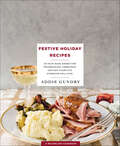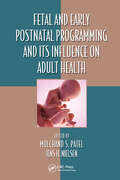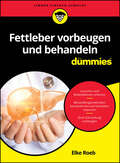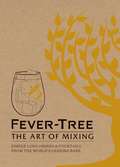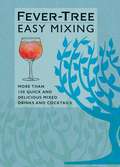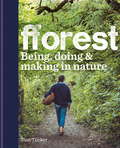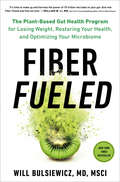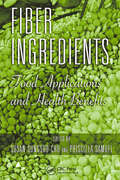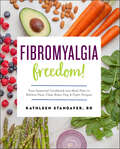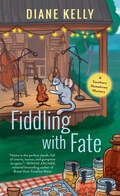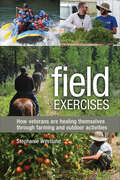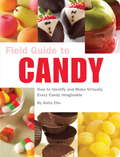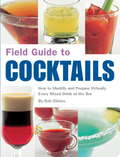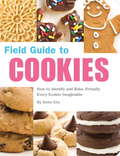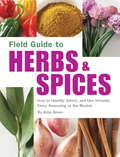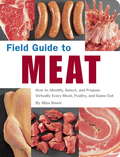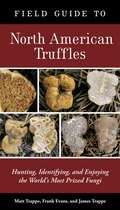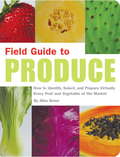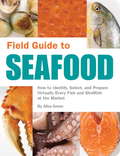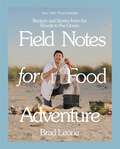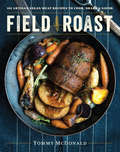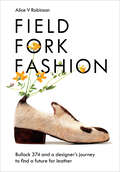- Table View
- List View
Festive Holiday Recipes: 103 Must-Make Dishes for Thanksgiving, Christmas, and New Year's Eve Everyone Will Love (RecipeLion)
by Addie GundryIn Festive Holiday Recipes, Food Network star Addie Gundry offers easy, delightful holiday recipes all in one place for everyone looking for that last minute recipe for entertaining. There’s a reason it’s called the most wonderful time of the year. From easy appetizers for holiday and New Year’s Eve entertaining, like Caramelized Onion Tartlets, to recipes for The Best Roast Turkey and all your favorite sides, pies, and even leftover ideas, this book is a home cook’s trusty sous chef for easy and elegant entertaining throughout the holiday season. Three words to remember: Salted Caramel Eggnog. Each recipe is paired with a four-color, full-bleed photo.Recipe Lion is part of Prime Publishing LLC, a lifestyle multi-platform brand focused on cooking and crafting content. The Prime group receives over 68 million monthly page views, and over 7.9 million readers subscribe to Prime’s family of email newsletters. Prime has leveraged their extensive user base, search data, and SEO expertise to choose topics and recipes for the cookbook series.
Festive: Simple recipes, crafts and traditions for the perfect Christmas
by Francesca StoneMake Christmas magicIn this book, you'll find easy, accessible ways to embrace your festive spirit and create lasting memories with the family with a collection of traditions - old and new - including simple recipes, styling tips and crafts to make your celebrations meaningful and beautiful without the big spend.By using traditional, low-cost ingredients to create simple and tasty festive recipes and foraging, recycling, and using inexpensive items from around your home for cosy styling and beautiful crafts to keep or give as gifts, you can have a perfect, budget-friendly and more sustainable Christmas.Recipes will include Mini gingerbread house biscuits, Brie and cranberry waffles, Christmas Cake and Mince pies, with styling tips covering how to dress your front door, tree and shelves, and crafts ranging from honeycomb paper trees to creating needle felted ornaments, recycled wax candles and natural beaded garlands.This is a book you'll reach for year on year.
Fetal and Early Postnatal Programming and its Influence on Adult Health (Oxidative Stress and Disease)
by Mulchand S. Patel Jens H. NielsenThere is a documented link between fetal nutrition and the development of disease risk in adult life. Including the early postnatal period, during which a newborn continues to grow rapidly influenced by environmental factors, suggests that individuals are subject to risks for more than just the fetal period. Fetal and Early Postnatal Programming and its Influence on Adult Health focuses on interrelated aspects of cellular programming related to early nutrition and this potential global health problem.
Fettleber vorbeugen und behandeln für Dummies (Für Dummies)
by Elke RoebEin Buch für mehr Lebergesundheit Leiden Sie an einer Fettleber oder hat Ihnen Ihr Arzt gesagt, Sie sollten Ihr Verhalten umstellen, da sich sonst eine entwickeln könnte? Da kann Ihnen dieses Buch helfen. Elke Roeb erklärt Ihnen verständlich, was eine Fettleber ist und wie sie entsteht. Unaufdringlich gibt die Autorin Ihnen Ratschläge, was Sie gegen eine Fettleber machen können oder wie Sie deren Entwicklung vermeiden. Sie stellt Lebensmittel vor, die Sie meiden sollten, und auch solche, die Ihnen helfen. Daneben erklärt sie, welche medizinischen Behandlungsmöglichkeiten es gibt und vieles mehr. Sie erfahren Welche Funktion Ihre Leber hat und wie sie aufgebaut ist Welche Ursachen und Risikofaktoren es gibt Wie Fettleber, Leberfibrose und -zirrhose zusammenhängen Welche Maßnahmen, Medikamente und Operationen helfen können
Fever Tree - The Art of Mixing: Simple long drinks & cocktails from the world's leading bars
by FeverTree Limited'The Ultimate G&T' -- Jamie Oliver'The best tonic on the planet' -- Ashton KutcherThe first cocktail book to put the mixers centre-stage, from brilliant Fever-Tree brand and created by leading bartenders around the world.Rather than starting with the spirits, this book focuses on key mixers - including tonic, lemonade, ginger ale, ginger beer and cola. Leading bartenders have created 125 classic and contemporary cocktail recipes that make the most of the botanical partnerships.The book also explores the origins of key ingredients, including quinine, lemons and elderflower, revealing the role quinine has played in geo-politics, for example, and the impact different herbs have on taste. In the way that we increasingly want to know the source and production methods of the food we eat, so this guide allows you to understand more fully what we drink - and use that knowledge to create the most delicious cocktails.
Fever Tree - The Art of Mixing: The Art Of Mixing - Simple Long Drinks And Cocktails From The World's Leading Bars
by Fever-Tree Limited'The Ultimate G&T' -- Jamie Oliver'The best tonic on the planet' -- Ashton KutcherThe first cocktail book to put the mixers centre-stage, from brilliant Fever-Tree brand and created by leading bartenders around the world.Rather than starting with the spirits, this book focuses on key mixers - including tonic, lemonade, ginger ale, ginger beer and cola. Leading bartenders have created 125 classic and contemporary cocktail recipes that make the most of the botanical partnerships.The book also explores the origins of key ingredients, including quinine, lemons and elderflower, revealing the role quinine has played in geo-politics, for example, and the impact different herbs have on taste. In the way that we increasingly want to know the source and production methods of the food we eat, so this guide allows you to understand more fully what we drink - and use that knowledge to create the most delicious cocktails.
Fever-Tree Easy Mixing: More than 150 Quick and Delicious Mixed Drinks and Cocktails
by FeverTree LimitedFrom the world's leading premium mixer brand, Fever-Tree Easy Mixing: More than 150 Quick and Delicious Mixed Drinks and Cocktails, is Fever-Tree's follow up to the bestselling Art of Mixing. With clever variations on the classic gin and tonic to a selection of spritzes, mules and mojitos, to some nifty no-and-low alcohol alternatives and a handful of pitchers for when the party really gets started, Fever-Tree Easy Mixing celebrates how easy it is for anyone to enjoy quick and delicious drinks at home.
Fever-Tree Easy Mixing: More than 150 Quick and Delicious Mixed Drinks and Cocktails
by FeverTree Limited***'Thanks, Fever-Tree for de-mystifying the whole mixing business and making us all Cocktail Masters. There's no excuse now: here's the secret to great, refreshing, stylish serves first time, every time!'Ian Buxton, author Gin: The Ultimate Companion.From the world's leading premium mixer brand, Fever-Tree Easy Mixing: More than 150 Quick and Delicious Mixed Drinks and Cocktails, is Fever-Tree's follow up to the bestselling Art of Mixing. With clever variations on the classic gin and tonic to a selection of spritzes, mules and mojitos, to some nifty no-and-low alcohol alternatives and a handful of pitchers for when the party really gets started, Fever-Tree Easy Mixing celebrates how easy it is for anyone to enjoy quick and delicious drinks at home.
Fforest: Being, Doing & Making in Nature
by Sian TuckerCalming to the soul and good for us all, spending time outdoors offers us precious breathing space away from the stresses and strains of modern life. This inspirational guide celebrates the life enhancing effect of nature and encourages you to try the pursuits that would have been second nature to previous generations - from walking in the dark with only the light of the moon and stars to guide you, to wild swimming, forest bathing and sleeping under canvas. It will inspire you to re-discover the joy of sky and clouds, night and tides, stars and silence. <P><P>Photography by Finn Beales
Fiber Fueled: The Plant-Based Gut Health Program for Losing Weight, Restoring Your Health, and Optimizing Your Microbiome
by Will BulsiewiczA bold new plant-based plan that challenges popular keto and paleo diets, from an award-winning gastroenterologist.The benefits of restrictive diets like paleo and keto have been touted for more than a decade, but as renowned gastroenterologist Dr. Will Bulsiewicz, or "Dr. B," illuminates in this groundbreaking book, the explosion of studies on the microbiome makes it abundantly clear that elimination diets are in fact hazardous to our health. What studies clearly now show--and what Dr. B preaches with his patients--is that gut health is the key to boosting our metabolism, balancing our hormones, and taming the inflammation that causes a host of diseases. And the scientifically proven way to fuel our guts is with dietary fiber from an abundant variety of colorful plants.Forget about the fiber your grandmother used to take--the cutting-edge science on fiber is incredibly exciting. As Dr. B explains, fiber energizes our gut microbes to create powerhouse postbiotics called short-chain fatty acids (SCFAs) that are essential to our health. SCFAs are scientifically proven to promote weight loss, repair leaky gut, strengthen the microbiome, optimize the immune system, reduce food sensitivities, lower cholesterol, reverse type 2 diabetes, improve brain function, and even prevent cancer. Restrictive fad diets starve the gut of the critical fiber we need, weaken the microbes, and make our system vulnerable.As a former junk-food junkie, Dr. B knows firsthand the power of fiber to dramatically transform our health. The good news is that our guts can be trained. Fiber-rich, real foods--with fruits, vegetables, whole grains, seeds, nuts, and legumes--start working quickly and maintain your long-term health, promote weight loss, and allow you to thrive and feel great from the inside out. With a 28-day jumpstart program with menus and more than 65 recipes, along with essential advice on food sensitivities, Fiber Fueled offers the blueprint to start turbocharging your gut for lifelong health today.
Fiber Ingredients: Food Applications and Health Benefits
by Susan Sungsoo Cho Priscilla SamuelThis book summarizes available fiber sources and how they can be incorporated into new food products to provide improved health benefits. It rigorously examines health claims, recent research, and contradictory data; covers fiber for weight and glycemic control, and intestinal regularity; and discusses how food producers can find fiber sources and
Fibromyalgia Freedom!: Your Essential Cookbook and Meal Plan to Relieve Pain, Clear Brain Fog, & Fight Fatigue
by Kathleen StandaferFight fibro the natural way—with food.There's a vital connection between what you eat and how you feel. Fibromyalgia Freedom! helps you manage your fibromyalgia naturally by taking control of your nutrition. This gourmet meal plan targets pain, lethargy, indigestion, and cognitive "brain fog," so you can find relief—and still eat well.The 4-stage plan starts you on a targeted diet, removing problematic foods to give your body a chance to heal. Over 110 recipes give you lots of engaging options to further reduce fibromyalgia symptoms. The recipes are brain- or immunity-boosting, and many are free of gluten, dairy, or allergens like nuts.In Fibromyalgia Freedom!, you'll find:4-week meal plan—Address fibromyalgia symptoms in four stages: Pain Management, Gaining Energy, Fighting Brain Fog, and Promoting Healthy Digestion.110+ nourishing recipes—Enjoy Thai Coconut Milk Soup, Crispy Baked Parsnip Fries, Italian-Style Meatballs, Creamy Chocolate Mousse, and more.Symptom tracking—Regain control of your health using a guided tracking strategy, made easy with charts for your symptoms, foods, and weekly progress.This holistic approach to fibromyalgia treatment will put you on the path to a more stress-free and symptom-free life.
Fiddling with Fate (A Southern Homebrew Mystery #3)
by Diane KellyWhen a local bluegrass musician disappears and a jug of her shop&’s corn liquor is implicated, moonshiner Hattie Hayes must stop further trouble from brewing in this delightful cozy mystery series.It&’s August in Chattanooga, Tennessee and moonshiner Hattie Hayes has collaborated with a nearby vineyard to serve her moonshine at a Wine and 'Shine event. Not only is this an opportunity for Hattie to gain more moonshine fans, but she&’s also excited to hear the Bootlegging Brothers, a popular bluegrass band. But not every attendee is looking for harmony. When one of the brothers disappears and is presumed dead, Hattie realizes her grace note gathering has suddenly turned more sour than her mash.Unearthing what happened to the missing musician is more difficult than Hattie first expected. Hattie&’s moonshine is tied to the crime and there&’s no time to fiddle around—she has to step up to solve the case. Luckily, Hattie&’s cool head and quick mind help her understand that when investigating a musical crime, always stay sharp.
Field Exercises: How Veterans Are Healing Themselves through Farming and Outdoor Activities
by Stephanie WestlundHow connecting with nature is helping veterans reintegrate into civilian life and recover from PTSD.There are nearly twenty-five million veterans and active-duty soldiers in North America. Some experts estimate that more than one quarter of these men and women suffer from post-traumatic distress, and many other military persons experience difficulty reintegrating into civilian life. While conventionally prescribed treatments primarily involve medication and therapy, many people are discovering additional ways to manage their injuries and reduce their suffering.Field Exercises: How Veterans Are Healing Themselves through Farming and Outdoor Activities shares the compelling stories of men and women who are finding relief from stressful and traumatic military experiences, while also establishing community networks and other peer support initiatives. Stephanie Westlund examines:The deep and far-reaching connections between nature and human healthThe tremendous impact of stress and trauma on survivors' livesResources and groups providing opportunities in the emerging field of “Green Care”.Field Exercises offers hope for veterans searching for methods to ease the transition to civilian life and recover from military stress and trauma. This book will appeal to millions of North American soldiers, veterans, and their loved ones, doctors, psychiatrists, social workers and other caregivers, other groups struggling with high rates of stress and post-traumatic experience, and all those interested in the relationship between nature and human health.Stephanie Westlund holds a PhD in peace and conflict studies. She has been conducting research with veterans since 2009, and continues to be inspired by their courage and personal resolve to move through pain toward recovery, and their unrelenting desire to serve their communities.
Field Guide to Candy
by Anita Chu Tucker HoslerAt last, a field guide to making and identifying virtually every candy imaginable, from peanut-butter cups to mint meltaways! Field Guide to Candy is the definitive guide to candies from around the world, with more than 100 recipes and variations on such tried-and-true classics as caramel apples, rocky road, and lollipops as well as traditional international favorites like Turkish delight, truffles, and French pralines. This delectable guide introduces readers to the best techniques for creating chocolates; sugary sweets; creamy, sticky, chewy candies; nutty treats; and fun and simple classics. Every candy is photographed in glorious full color, with step-by-step instructions on how to prepare, make, and store your creations. Entries include fascinating historical background, helpful baking notes, and serving suggestions for each delicious variety. Whether you're a candy-making novice or veteran pastry chef, mouth-watering homemade confections are minutes away with Field Guide to Candy!
Field Guide to Cocktails
by Rob ChiricoFinally, a field guide to preparing and identifying virtually every drink at the bar, from the Añejo Highball to the Caipirinha, from the Singapore Sling to the Zombie! Field Guide to Cocktails is not an ordinary bartender's guide. Here are more than 200 recipes for the world's best libations, with tried-and-true classics like the Tom Collins and the Fuzzy Navel and contemporary favorites like the Mojito and the Cosmopolitan. Full-color photographs of the cocktails are cross referenced to in-depth descriptions of the drinks. The histories are the stuff of legend: The Gin Rickey was mixed up to satisfy a thirsty lobbyist; Grog was drunk by sailors in the British Navy to prevent scurvy; and the Gibson was originally just a glass of water with an onion in it. You'll also learn the most appropriate time and season to enjoy the drink, and you'll get suggestions for the perfect food pairings--lobster with a Cape Codder, sharp cheese and crackers with a Gin and Tonic, black bean dip and chips with a Cuba Libre, and more. So whether you're planning a cocktail party or trying to identify a new drink to try at the bar, Field Guide to Cocktails is the only mixology book you'll ever need. Cheers!
Field Guide to Cookies
by Anita Chu Caroline RomanskiAt last, a field guide to baking and identifying virtually every cookie imaginable, from Snickerdoodles to Pfeffernusse! Field Guide to Cookies is the definitive guide to cookies from around the world, with more than 100 recipes and variations on such tried-and-true classics as gingersnaps, whoopie pies, and pinwheels as well as traditional international favorites like pizzelles, baklava, and alfajores. This delectable guide introduces readers to the best techniques for creating drop, bar, molded, rolled, and sandwich variations. Every cookie is photographed in glorious full color, with step-by-step instructions on how to prepare, bake, and store your creations. Entries include fascinating historical background, helpful baking notes, and serving suggestions for each delicious variety. Whether you're a baking novice or veteran pastry chef, mouthwatering home-baked confections are just minutes away with Field Guide to Cookies!
Field Guide to Herbs and Spices
by Aliza GreenField Guide to Herbs & Spices will forever change the way you cook. With this practical guide--including full-color photographs of more than 200 different herbs, spices, and spice mixtures--you'll never again be intimidated or confused by the vast array of spices available. Learn to discern the differences between the varieties of basil, the various colors of sesame seeds, the diverse types of sugar and salt, and even how to identify spice pastes like zhoug, harissa, and achiote. Each entry features a basic history of the herb or spice (saffron used to be worth more than gold!), its season (if applicable), selection and preparation tips, a recipe featuring the seasoning, and some suggested flavor pairings. Complete with more than one hundred recipes, Field Guide to Herbs & Spices is a must-have resource for every home cook. Meals will never be the same again!
Field Guide to Meat
by Aliza GreenAt last, a field guide to identifying and selecting more than 200 different cuts and kinds of meat, from beef and poultry to game and cured meat! An essential resource for every home cook or chef, Field Guide to Meat offers details on virtually every kind of meat available. This practical guide includes more than 200 full-color photographs of cuts of beef, veal, pork, lamb, game, and poultry as well as more than 100 different kinds of cured meats and sausages. Cross-referenced with the photographs are in-depth descriptions of the cuts, including basic history, location in the animal, characteristics, information on how to choose the cut, and flavor affinities. Step-by-step preparation directions tell you whether the item is best marinated, braised, grilled, roasted, or pan-seared. Trips to the butcher's aisle will no longer be intimidating, and you'll never end up with a cut that's too tough for dinner.
Field Guide to North American Truffles: Hunting, Identifying, and Enjoying the World's Most Prized Fungi
by James M. Trappe Frank Evans Matt TrappeThe second most expensive food in the world after saffron, truffles are treasured, coveted, and savored for their mysterious and exotic flavor. This complete field guide shows chefs and fungi aficionados how to forage for and identify the wide variety of truffles that grow in temperate forests throughout North America. Written by expert horticulturalists who have studied, classified, and enjoyed truffles for decades, the FIELD GUIDE TO NORTH AMERICAN TRUFFLES makes these celebrated underground jewels accessible to all. The first full-color illustrated guide to identifying North American truffles by their key features, including profiles of more than 80 species of truffles. Includes more than 80 photographs of rare and hard-to-find truffle species. Features flavor profiles, delectability index, and culinary tips for each species. Perfect size for carrying in a pocket or daypack.Reviews"It'¬?s the first book of its kind, complete with photographs, cross-sectional views of indigenous truffle varieties, guides to seasonal availability, and foraging tips for hundreds of kinds of truffles (both the edible and inedible kinds), as well as tasting notes and cooking tips."-SaveurFrom the Trade Paperback edition.
Field Guide to Produce
by Aliza GreenAt last, a field guide to identifying and selecting more than 200 fruits and vegetables from around the world! The perfect companion for every shopper, Field Guide to Produce offers tips for selecting, storing, and preparing everything from apples to zucchini. When an unfamiliar edible appears on your grocer's shelf, simply flip through the full-color insert until you've found its photograph. Turn to the corresponding page to discover its country of origin, common uses, and season of harvest. This practical guide includes more than 200 full-color photographs of the world's most popular fruits and vegetables, cross-referenced to in-depth descriptions and selection tips. Step-by-step preparation directions tell you whether the item must be peeled, washed, trimmed, or blanched. Grocery shopping--and dinner--will never be the same again!
Field Guide to Seafood
by Aliza GreenAt last, a field guide to identifying and selecting seafood from around the world, including barramundi, lobsterette, wahoo, and more! With the daunting array of fish and shellfish available in today's market, Field Guide to Seafood is a must-have for every seafood consumer! This helpful guide offers a comprehensive look at seafood, covering more than 100 different kinds of fish and shellfish, plus preserved fish, fish sauces, and caviar. Learn to differentiate between Arctic char and salmon or between snow crabs and stone crabs with the in-depth descriptions and full-color photographs. Each entry contains a list of alternate names, characteristics, and suggested preparation, including directions on when to remove or leave the skin. Step-by-step instructions explain how to identify, store, and cook the item. Whether your fish is store-bough or just caught, this guide includes selection tips, suggested recipes, and complementary flavors. You'll never feel overwhelmed by the wide variety of seafood with this handy guide -- don't go shopping without it!
Field Notes for Food Adventure: Recipes and Stories from the Woods to the Ocean
by Brad LeoneA FOOD52 BEST COOKBOOK OF THE YEARJoin Brad Leone, star of Bon Appetit's hit YouTube series It's Alive, for a year of cooking adventures, tall tales, and fun with fire and fermentation in this cookbook with more than 80 ingenious recipes Come along with Brad Leone as he explores forests, fields, rivers, and the ocean in the hunt for great food and good times. These pages are Brad&’s field notes from a year of adventures in the Northeast, getting out into nature to discover its bounty, and capturing memorable ideas for making delicious magic at home anytime. He taps maple trees to make syrup, and shows how to use it in surprising ways. He forages for ramps and mushrooms, and preserves their flavors for seasons to come. He celebrates the glory of tomatoes along with undersung fruits of the sea like squid and seaweed. Inspiration comes from hikes into the woods, trips to the dock, and cooking poolside in the dead of summer. And every dish has a signature Brad Leone approach—whether that&’s in Sous Vide Mountain Ribs or Spicy Smoked Tomato Chicken, Sumac Lemonade or Fermented Bloody Marys, Cold Root Salad, Marinated Beans, or just a few shakes of a Chile Hot Sauce that&’s dead simple to make. This is a book about experimentation, adventure, fermentation, fire, and having fun while you&’re cooking. And hey, you might just learn a thing or two. Let&’s get going!
Field Roast: 101 Artisan Vegan Meat Recipes to Cook, Share, and Savor
by Tommy McdonaldHailed as 2015's Company of the Year by VegNews Magazine, the Field Roast Grain Meat Co. offers their first cookbook, with over 100 delicious, satisfying vegan recipesIn Field Roast, Chef Tommy McDonald shares fundamental techniques and tips that will enable you to make your own vegan meats at home--for everyday (sandwiches, burgers, meatloaf) to holiday (stuffed roast, anyone?), as well as recipes for using them in every meal from breakfast through dinner. The 100 recipes are flexible: want to make your own plant-based meats? Great! Want to use Field Roast products instead? That will work too. All you need are grains, veggies, and spices--easy-to-find whole food ingredients for authentic, hearty taste. With basics such as cutlets and sausages, along with dishes like Burnt Ends Biscuit Sandwich, Chicken Fried Field Roast and Waffles, Pastrami on Rye, Tuscan Shepherd's Pie, Curry Katsu, (and even some favorite desserts), Field Roast brings new meaning to plant-based meat.
Field, Fork, Fashion: Bullock 374 and a Designer’s Journey to Find a Future for Leather
by Alice V Robinson*From one of the Vogue Business 100 Innovators List - 2023 "[T]his wonderful project and book, executed with great charm and creativity, is an important message." Anya Hindmarch In this personal investigation into ethical and traceable leather, fashion designer Alice Robinson begins a ground-breaking journey into the origin story of leather and its connection to food and farming. As a fashion student, Alice started to question the material she worked with. Leather is universally acknowledged as a luxury material, from which desirable bags, shoes and clothing are made. But how much do we know about where it comes from? Alice’s questions led back to her childhood home in rural Shropshire, where she decided to buy Bullock 374 and follow its journey from a local farm to the abattoir, then to the butchery and finally to the tannery. The journey culminates with Alice’s own design practice as she creates a collection based on this single hide. In doing so, Alice would begin to see the bigger picture – and connect farm, food and fashion for the first time to understand the true meaning of provenance, value and beauty.
